El Paso Locomotive FC have one of the most unique playing styles found in the USL Championship. Coach Mark Lowry’s squad looks to retain possession and then (if necessary) regain possession as quickly as possible throughout the match. At the time of writing, El Paso finds itself in second place in the USL’s group C, five points behind New Mexico United with a game in hand. The club’s identity on the pitch stems from the playing concept known as positional play, which looks to seek a variety of superiorities across the pitch. While European clubs like Man City and UEFA Champions League Winners Bayern Munich serve as the gold standard for positional play, El Paso has quickly grown to be one of the flag-bearers for the style of play in the United States.
This tactical analysis looks to examine a few of the consistent tactics that Lowry has implemented in the squad. The analysis will highlight some of the principles that seemed to be instilled at the club when El Paso are in possession and looking to attack their opponent’s goal.
Numerical and positional superiority in the build-up
El Paso’s success in getting forward starts at the back. They look to progress the ball cleanly from their defensive third so as to create an advantage in the middle of the pitch. They rely on numerical superiority in order to do this, making sure to always have at least one additional player than their opponent. Their centre-backs and, typically, one midfielder work to progress up the pitch and break the first line of defensive pressure, although this is not always the case.
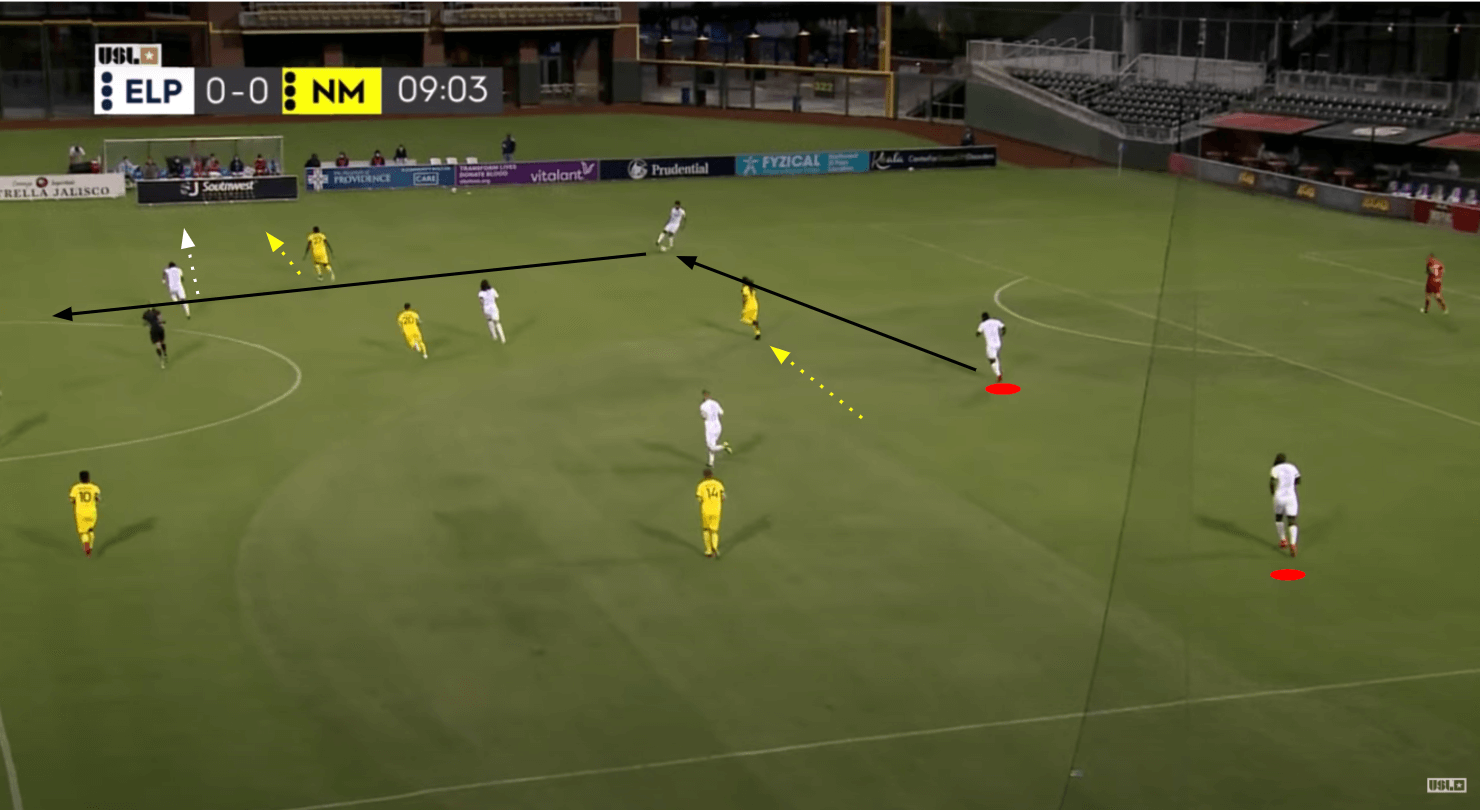
Here El Paso was looking to progress up the pitch against New Mexico United’s 4-2-3-1 press. Their centre-backs, marked in red, had shifted over to gain possession of the ball, then dropped in order to create more space. As the pair weren’t actually centred, their right-back, Bryam Rebellón, provided balance by dropping to form a back three. He had achieved excellent positional superiority by the time he received the ball because he was able to receive with both time and space to make a decision. As he looked forward to pass, Saeed Robinson ran towards the flank, dragging his defender with him. This allowed Rebellón to deliver a vertical ball to his teammate in the half-space, moving El Paso up the pitch in the process.
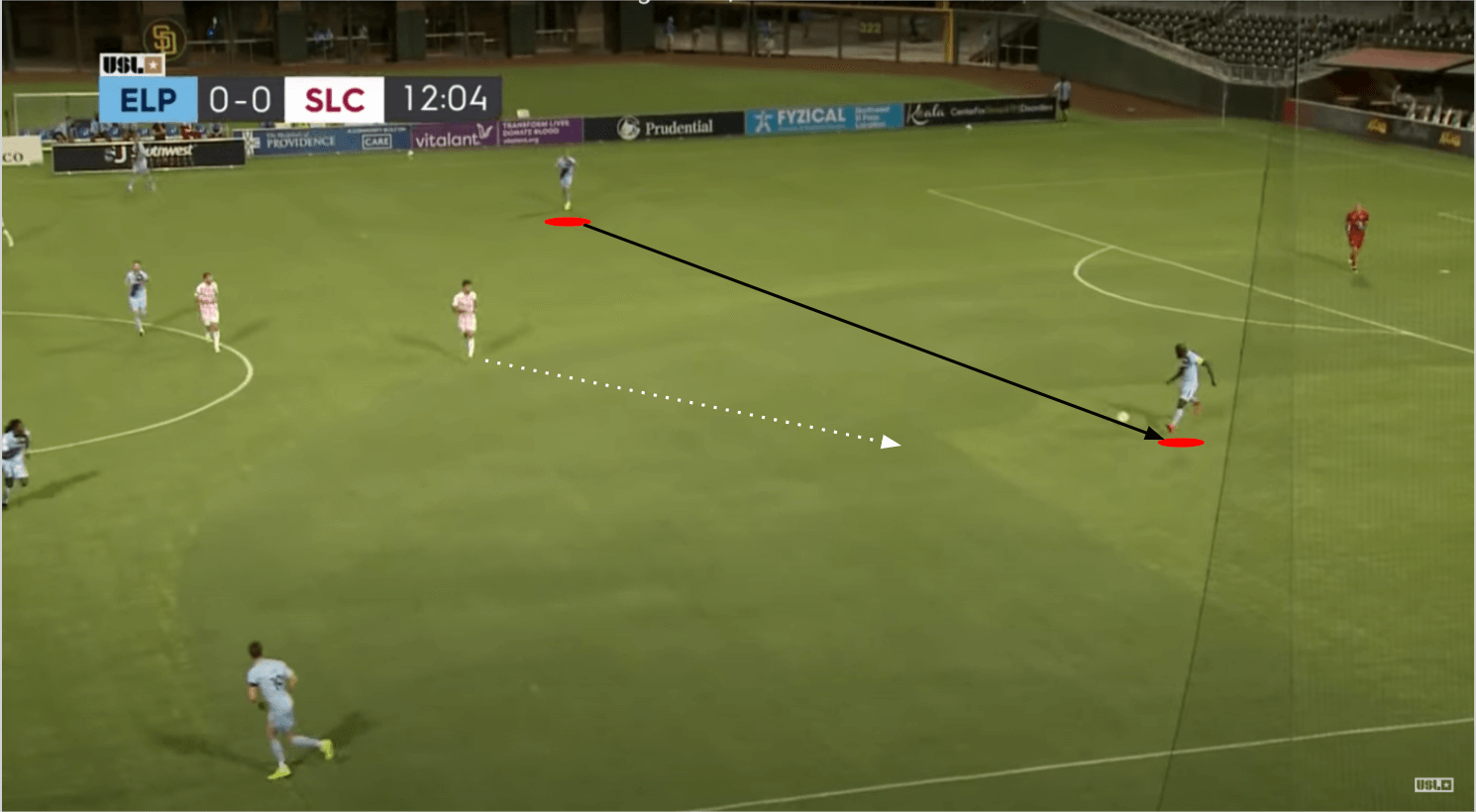
When teams press with a single forward, El Paso’s centre-backs will become incredibly wide for their 2v1 scenario. While maintaining a numerical superiority, they also make sure to have a positional superiority as well. In the image above, the long pass is made from Brent Kallman to Chiró N’Toko. This forced the defending forward to come all the way across the pitch to pressure N’Toko. El Paso made another two passes on the left side of the pitch, attracting even more attention and pressure from the opponent, before playing the ball back to Kallman, who was then able to dribble forward and engage a defender before delivering a pass to a teammate.
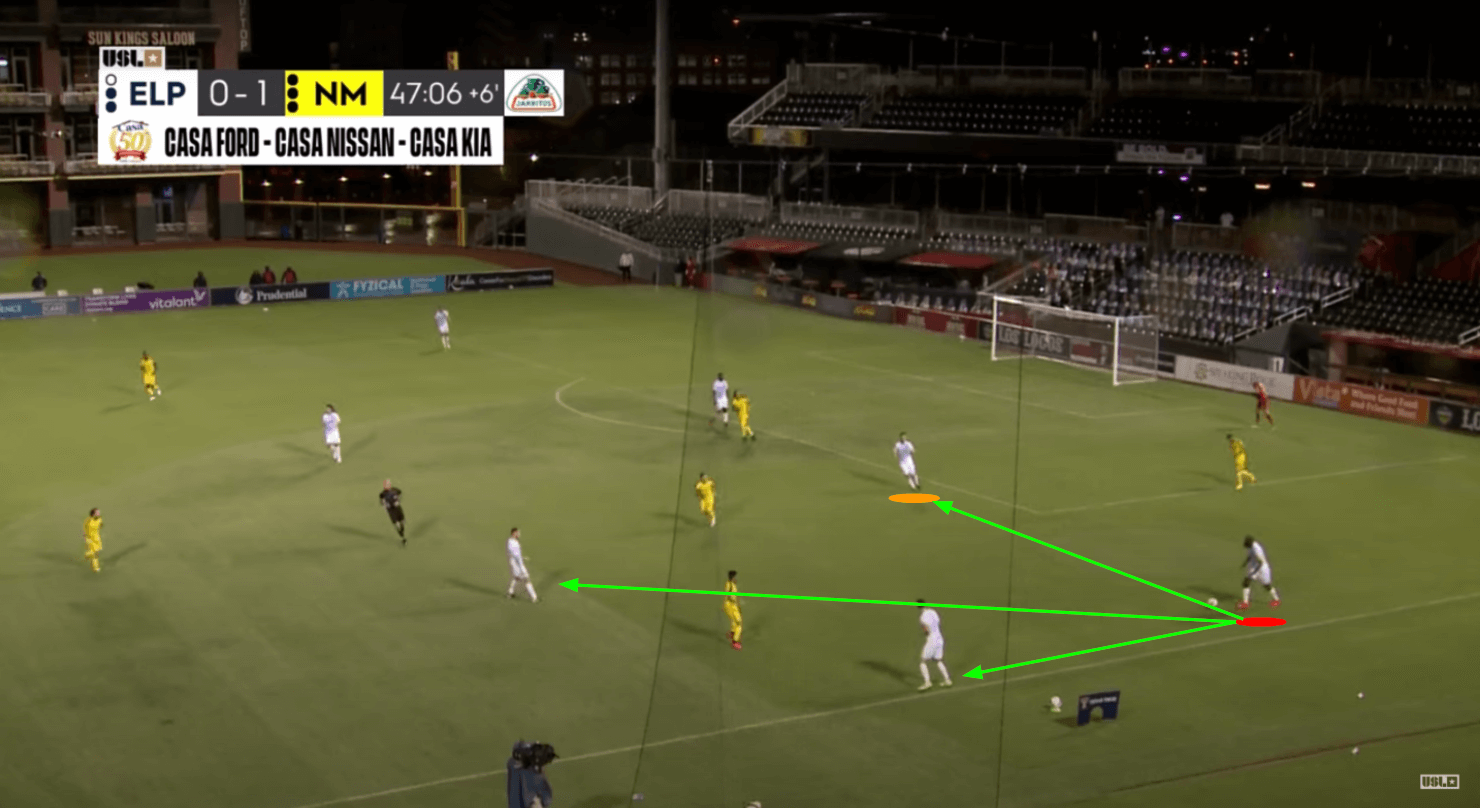
The centre-backs, whoever they are, have a lot of flexibility in terms of positioning. In the image above, Mechack Jérôme, marked in red, dropped all the way down to the touchline to receive the ball from his goalkeeper. Despite this, El Paso still achieved numerical and positional superiority. Their midfielder, marked in orange, dropped down to be both a passing option and an extra defender. On the left side of the pitch, Jérôme had three passing options highlighted in green. Across the entire defensive third, El Paso still had an additional man, not including their goalkeeper. These superiorities were actually recognised by New Mexico, who opted not to press and instead dropped back towards their own half.
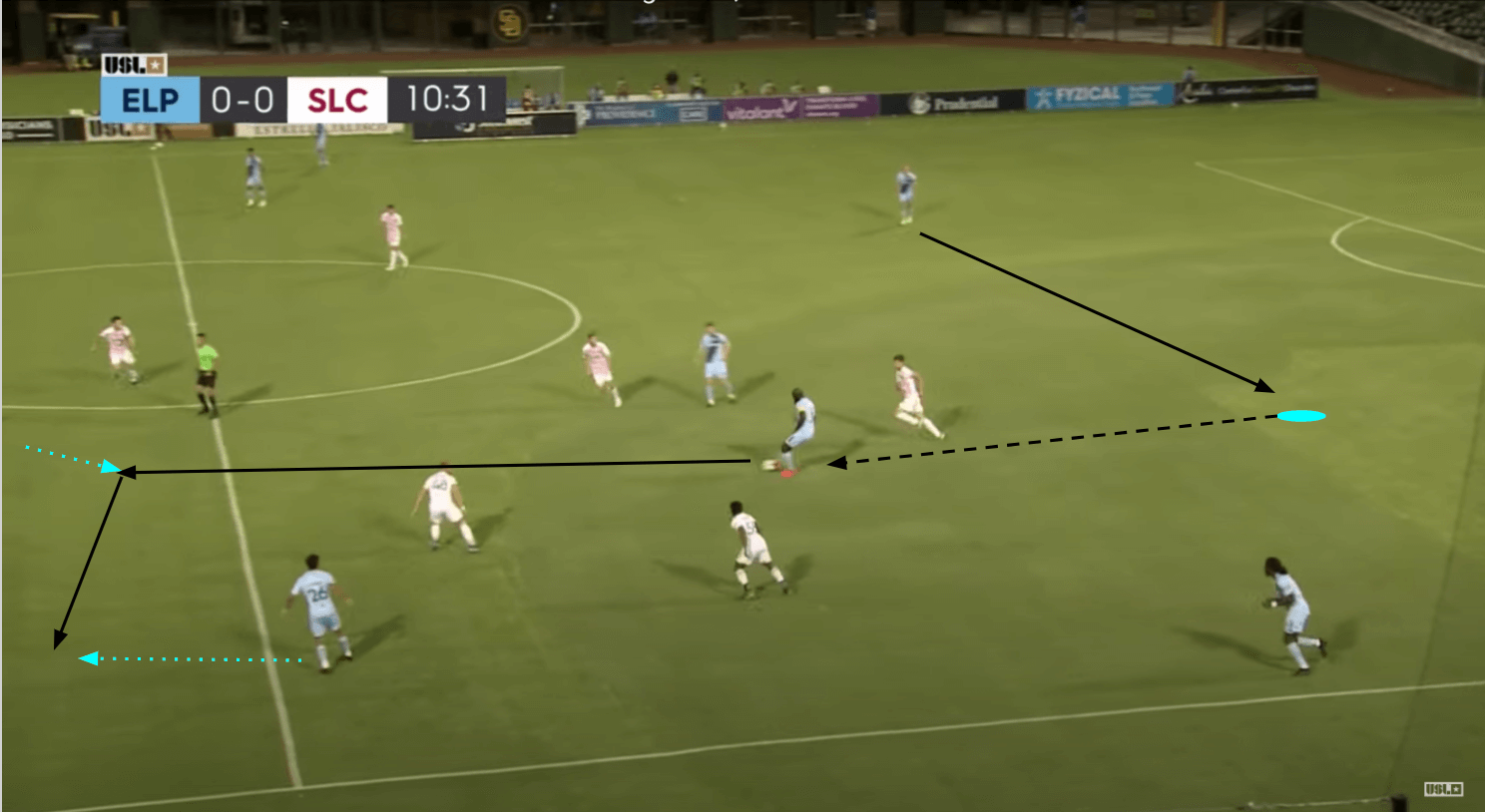
When centre-backs are able to, they are allowed to progress into the middle third of the pitch if the space and time allows. Against Real Monarchs SLC, El Paso again spread their centre-backs out wide. When not under pressure, N’Toko was happy to progress forward as he did above. His positional superiority allowed him to have time to dribble and attract pressure. This meant that he could transfer that superiority to where the ball ended up, because the opponents had to shift to prevent him from dribbling. His vertical pass found a teammate who used his first touch to play Josué Gómez, who was able to attack the Monarchs’ defence without any immediate pressure.
Overload to isolate across pitch
Another principle in possession that appears throughout El Paso’s play is the idea that they need to overload part of the pitch in order to draw in defenders so that they can isolate opponents in a 1v1 situation. El Paso does this consistently in all areas of the pitch, making sure to maintain their width to take advantage of the entire pitch.
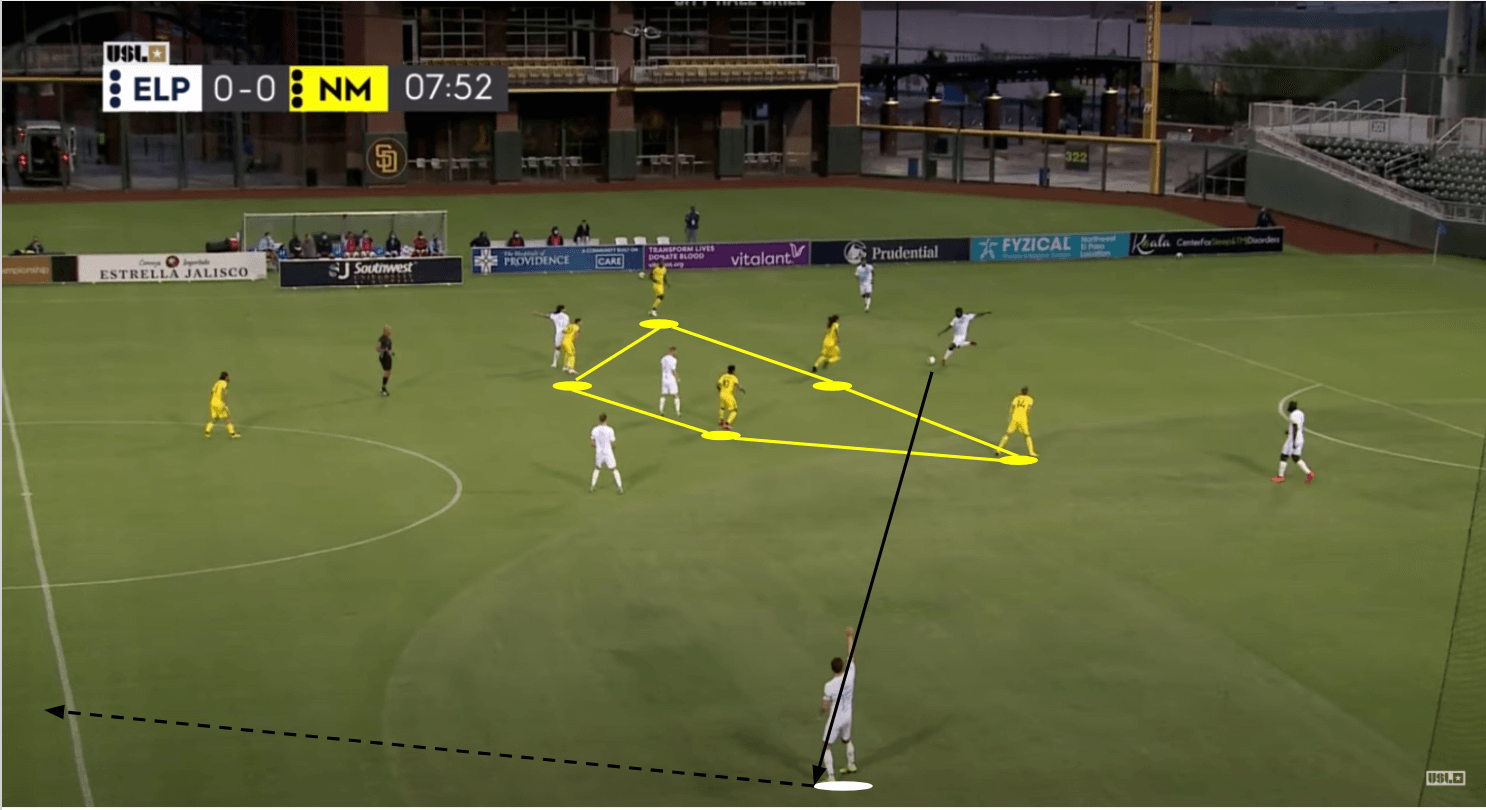
The backline is just as capable of drawing in pressure as anyone else on the pitch, and it allows them to progress into the middle third when they do. In the image above, El Paso was under pressure from New Mexico’s press, with half of New Mexico’s squad closing down. El Paso was able to maintain possession in this tight area, drawing the opponents in as they did. This opened up plenty of room for Andrew Fox at the bottom of the image. When he received the ball, Fox had plenty of time to turn up the field, dribble inside to attract pressure, and play it back to the wing for a cross. This space and time was created by their ability to overload the right-hand side so as to attack the left.
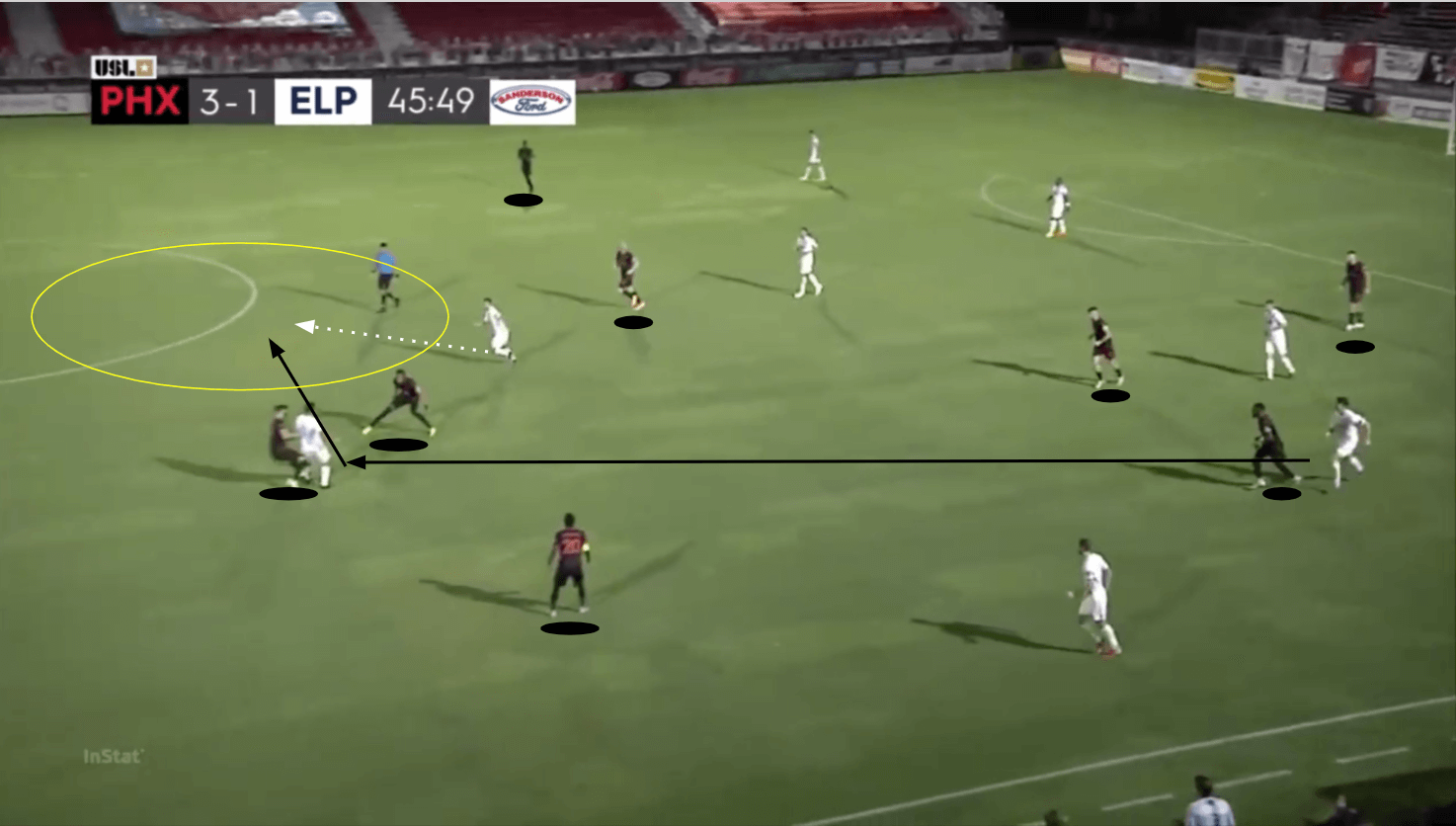
Against Phoenix Rising, El Paso demonstrated this same ability, which saw them pull a total of eight Rising players into El Paso’s half. From there, they executed a wonderful third man pass to break through, getting the ball to a midfielder in the centre of the pitch. While Dylan Mares was unable to pick out the right pass, he was in the perfect position to split two Rising defenders and play his teammate in behind.
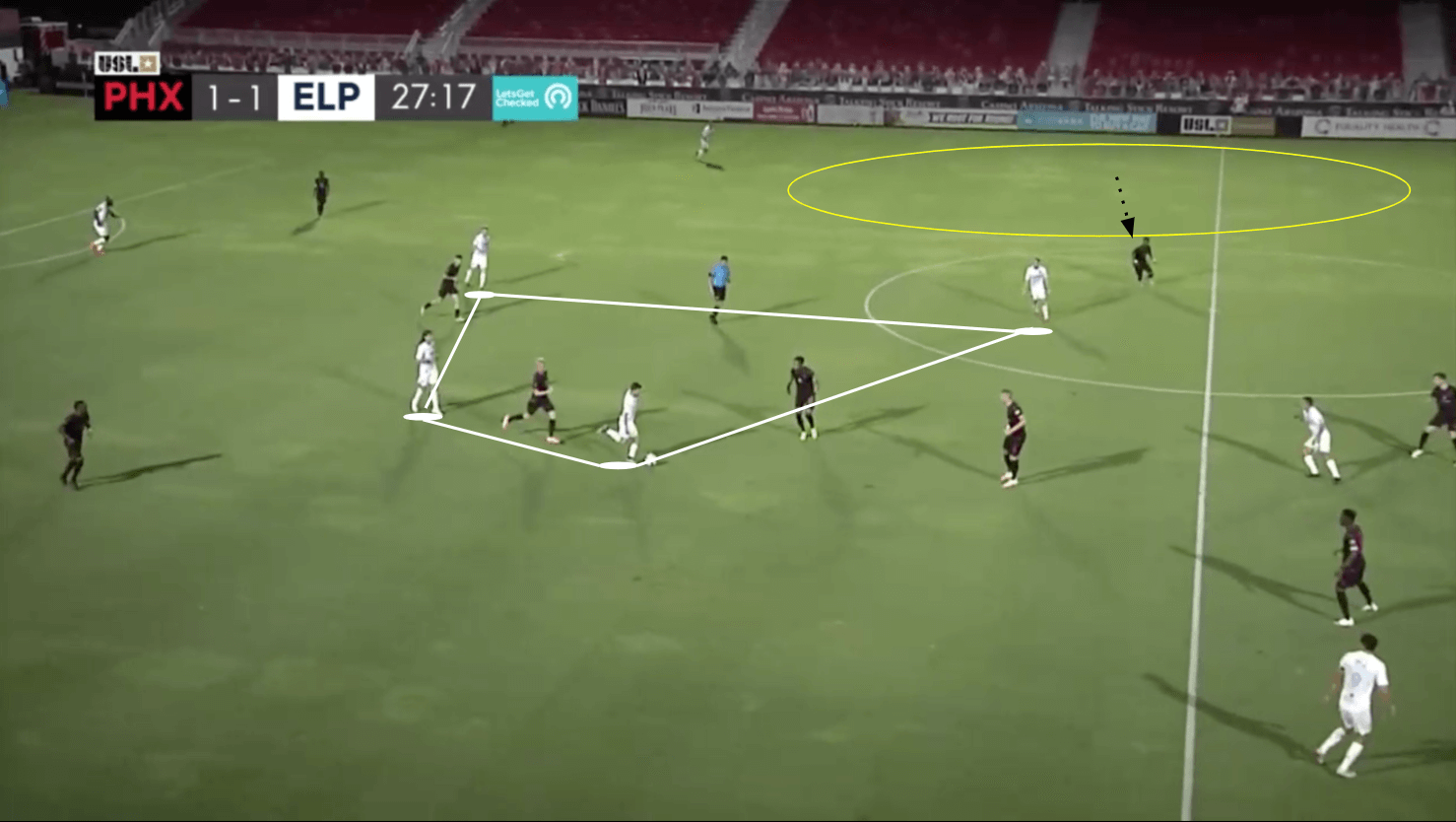
El Paso has also overloaded the middle of the pitch in order to create space on the sides. Against Phoenix, they formed a box-like structure in the middle of the pitch, outnumbering Rising’s midfield in the process. This meant that Phoenix had to pull a player out of position if they didn’t want El Paso playing through the centre of the pitch. The result of this was Phoenix using their outside backs to come inside, as shown above. When this would happen, large amounts of space would open up for El Paso as they again looked to draw in pressure before releasing to a teammate who was open in space.
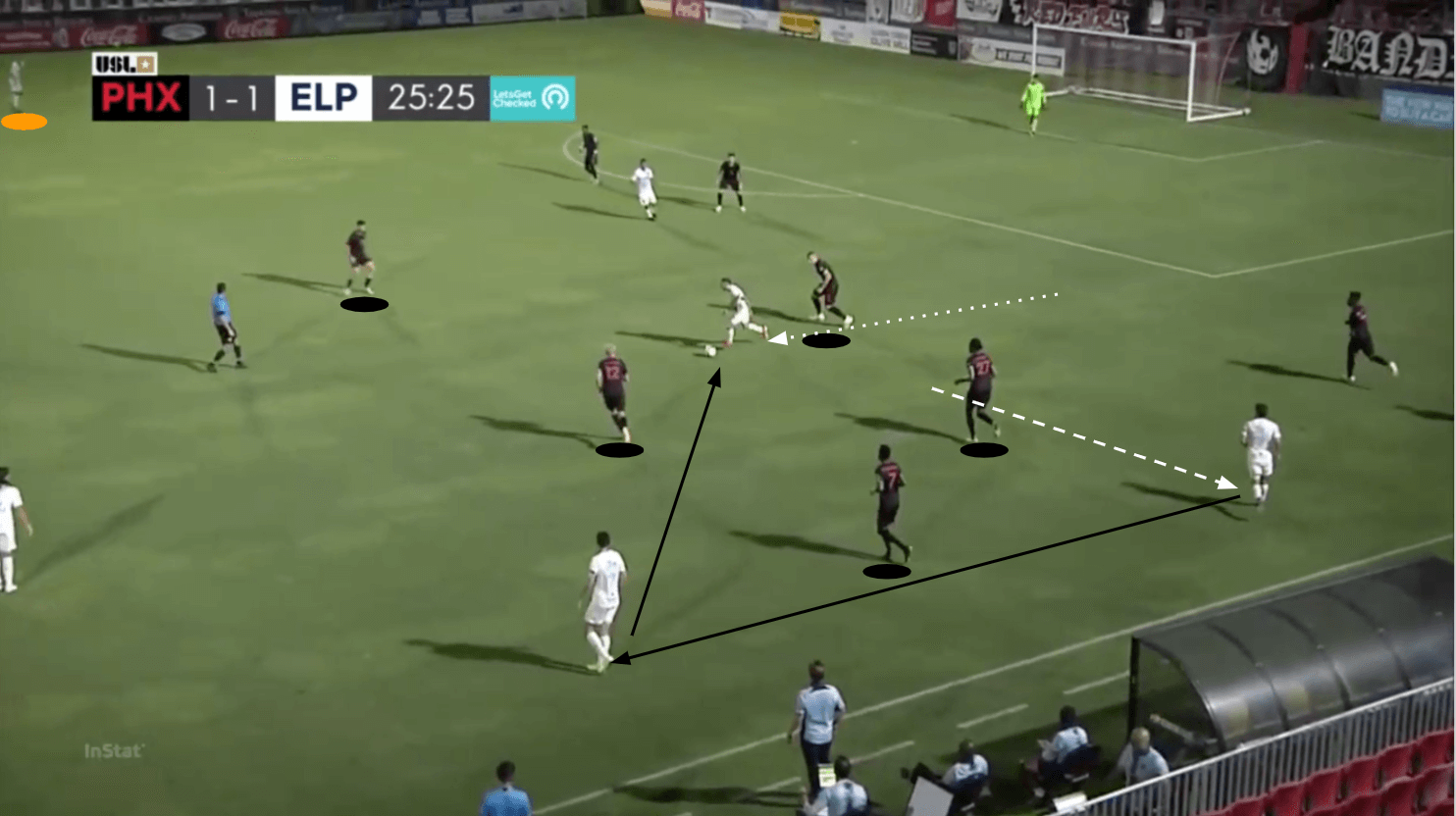
Again against Phoenix, El Paso used positional rotation to attract pressure. Dylan Mares received the ball in the half-space, drawing in the Phoenix defender as he dribbled toward the touchline. As Mares vacated the space, his teammate quickly arrived to receive the ball in that very space. As he did, the Rising defenders collapsed on him, the man at the top of the image, marked in orange, became even more open. Both the left flank and the left half-space were unoccupied by a Rising player, and a misplaced pass was the only reason El Paso wasn’t in on goal.
Find the forward-facing man to break lines
One of the core principles that Lowry seems to have implemented is the necessity to maintain possession rather than immediately attack defenders in 1v1 situations or progress in areas that won’t result in a chance on target. El Paso don’t necessarily look to run around opponents, but rather they’d prefer to rely on teammates to pass through them. A simple run that seems to be consistently applied is that if you’re under pressure, find the open man who is facing the opponent’s goal.
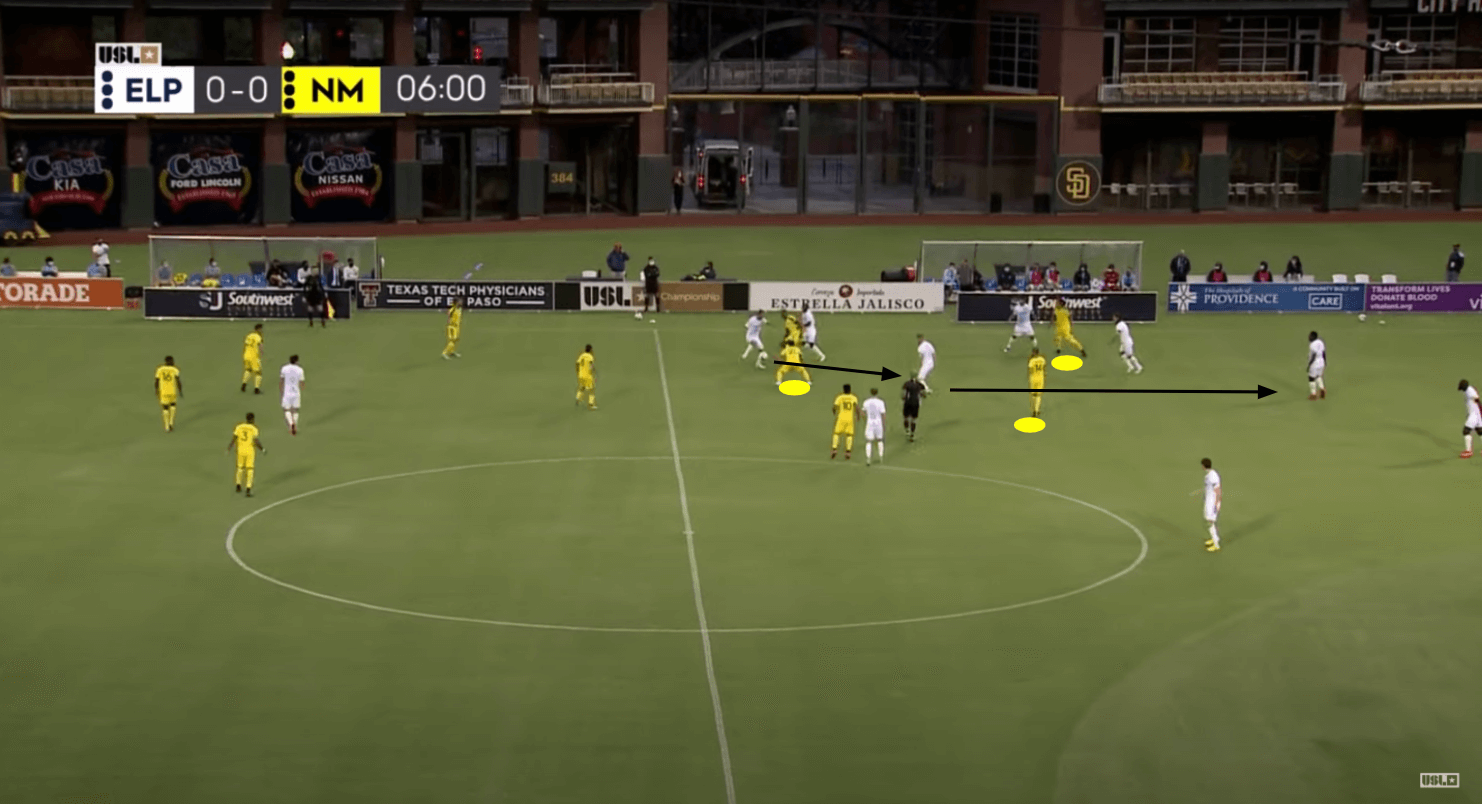
A prime example of this is shown above, as El Paso were attempting to control the second ball after an aerial duel. Marios Lomis did well to put himself in position to control the ball. He used his first touch to pass to his teammate behind him. That teammate was immediately put under immense pressure as he was surrounded by three New Mexico defenders. Recognising the pressure, he turned and played the ball back to Mechack Jérôme, who in this instance was the forward-facing player. Jérôme wasn’t able to break any lines with his pass, but he did play the ball to N’Toko, who quickly got El Paso out of pressure and up the pitch by playing the ball to Fox. Both N’Toko’s pass and Fox’s run broke lines of pressure, but it only happened because their teammates understood they had players in supportive positions.
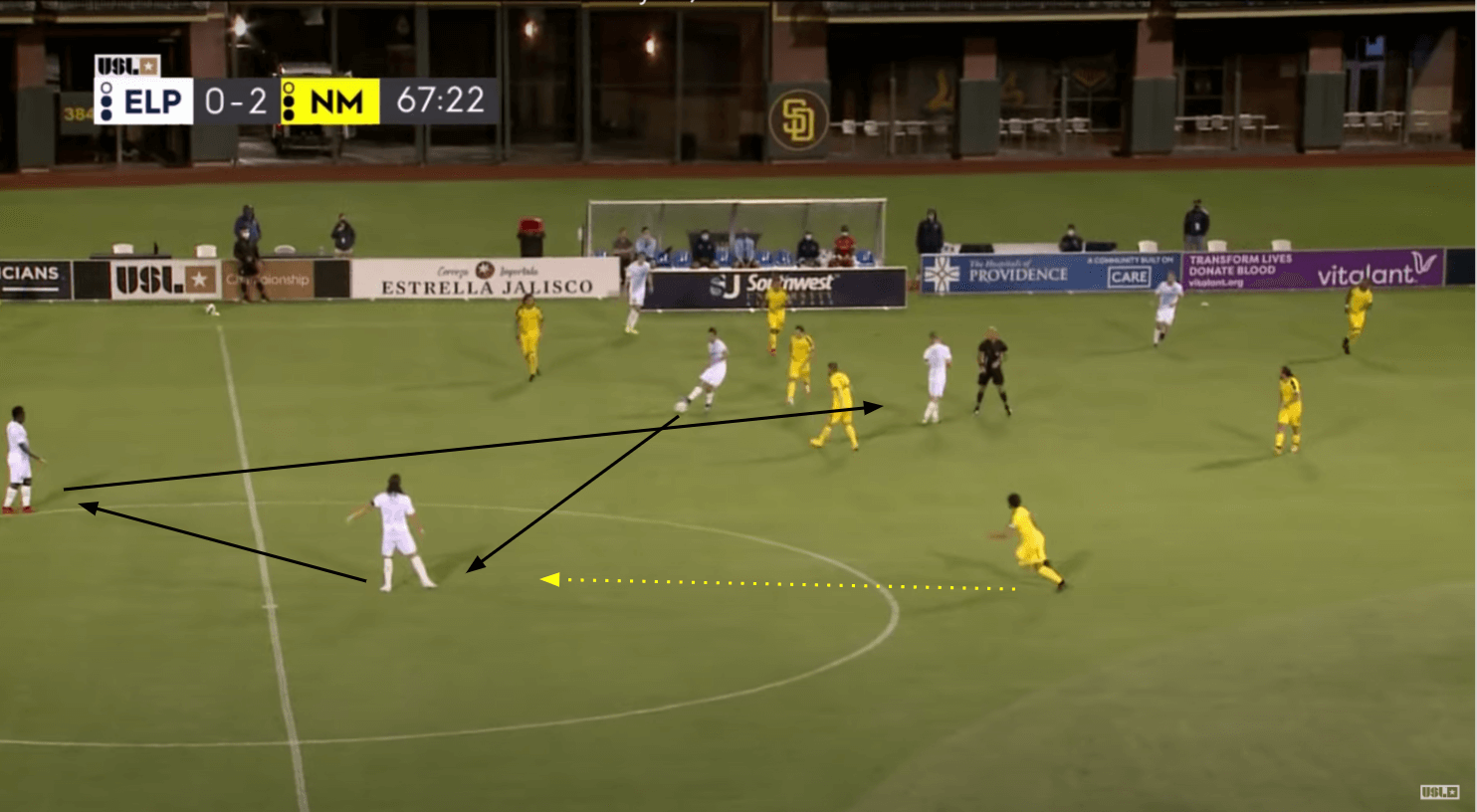
Another example of El Paso following this principle comes from the same match. As El Paso looked to progress through the centre of the pitch, they continually ran into opponents. Dylan Mares was the man on the ball in the image above. Under pressure, he played a pass to his teammate Yuma, who was the forward-facing man. Almost immediately, Yuma was put under pressure by a New Mexico defender. Yuma applied this same principle and found Jérôme, who was open with time and space. The result of these consecutive passes opened up space between the lines, and Jérôme was able to break the first line of defensive pressure with his pass, allowing El Paso to finally progress up the centre of the pitch.
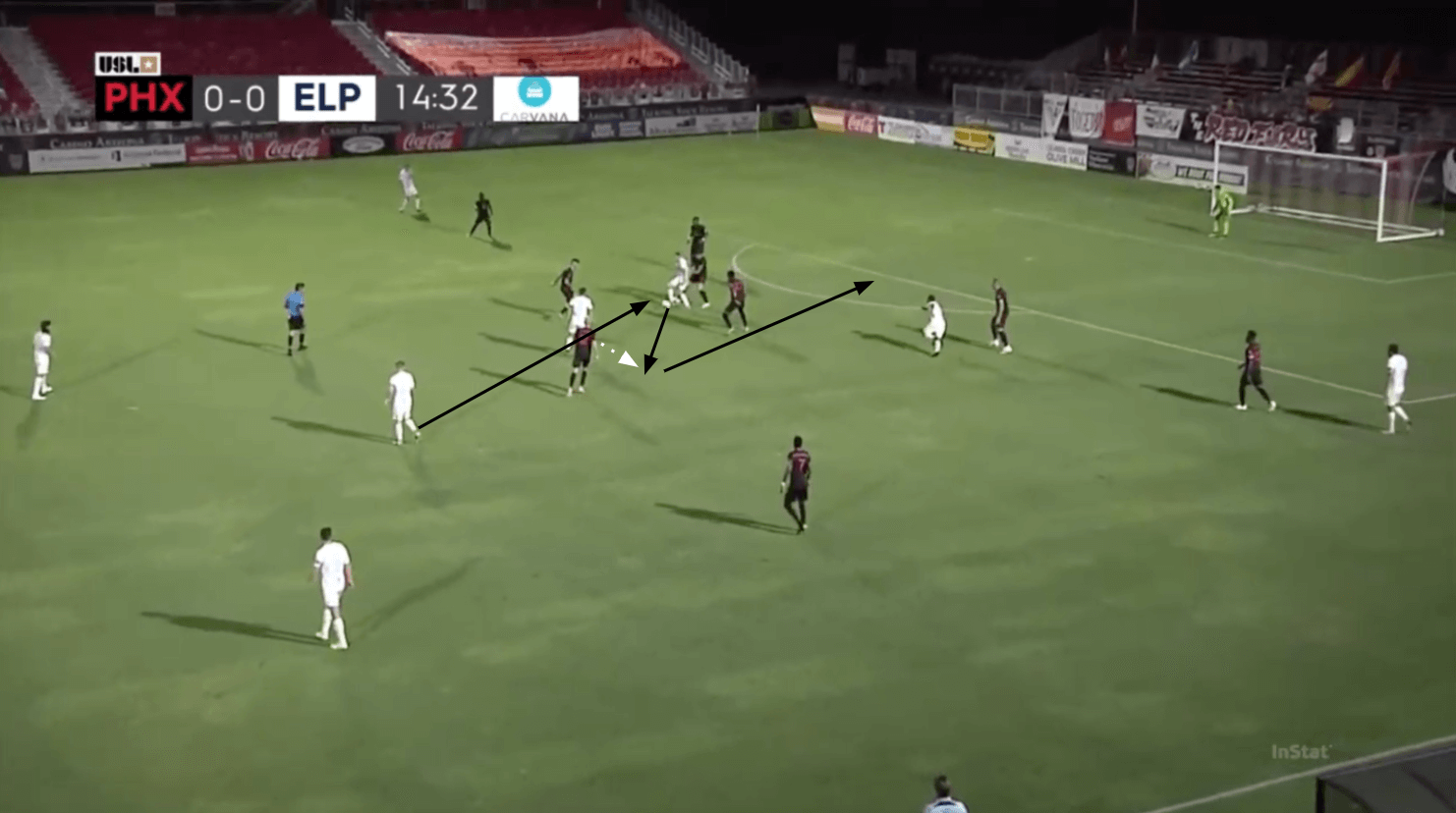
Against Phoenix, El Paso executed this in the form of a third man pass on their way to scoring their only goal of the match. After a long vertical pass forward, Nick Ross laid the ball off for Mares with his first touch. Mares, the man facing forward and thus able to understand the time and space properly, slotted a pass to Gómez, who finished the chance for El Paso. While this goal should certainly be appreciated, the initial ball into Ross occurred after their right-winger opted to maintain possession and find a forward-facing player as opposed to taking on his defender at the edge of the penalty area. The need to maintain possession and use it as a means to an end allows El Paso to manipulate and then exploit their opponents’ positioning.
Interior passes to create space on flanks
Another principle that seems to be consistent, especially in the final third, is El Paso’s passes towards the interior in order to create room on the outside of the pitch. A lot of El Paso’s progressions through the zones occur on the flanks, and so they use these interior passes in order to create room to attack.
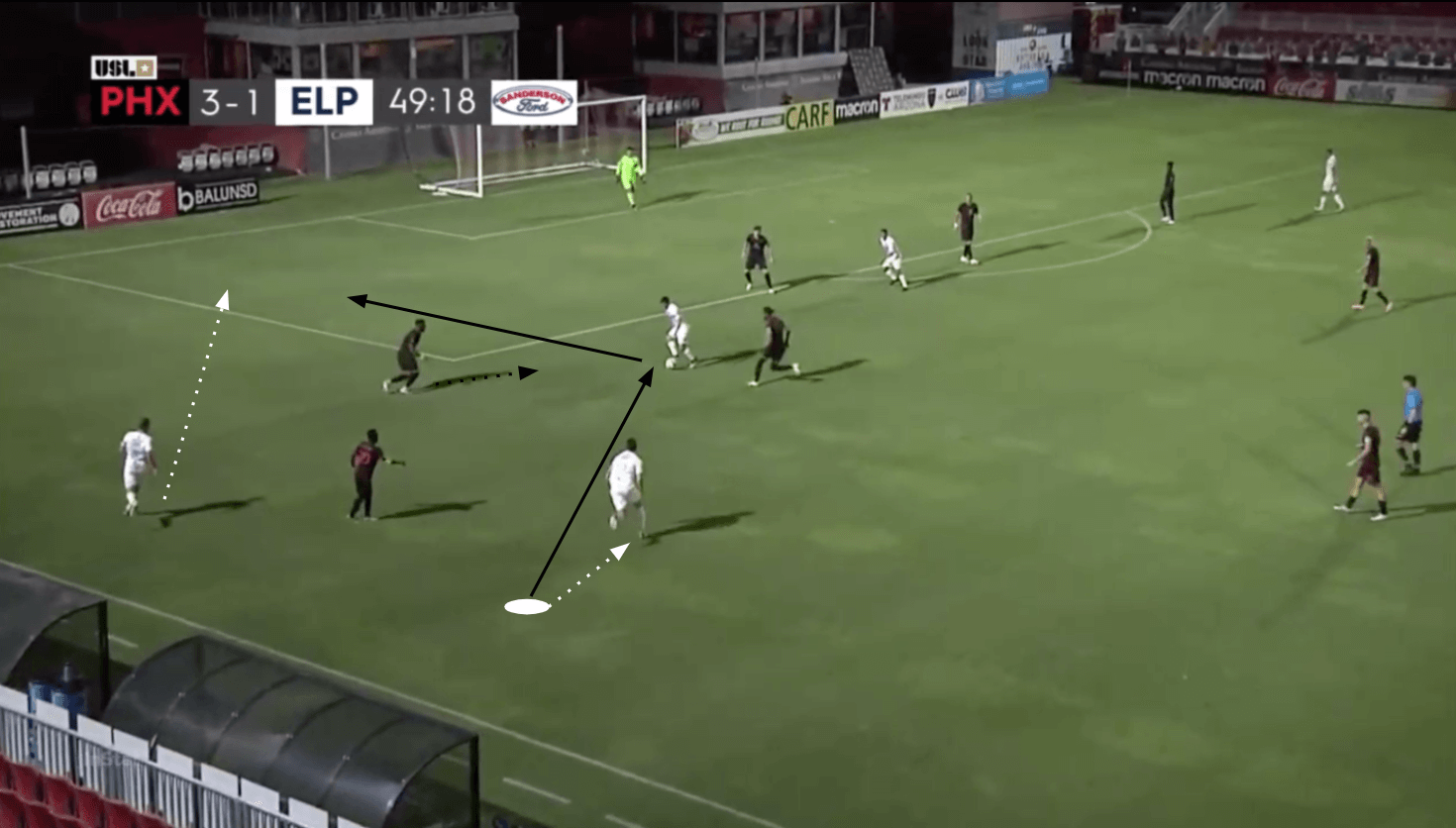
Against Phoenix, Fox was overlapped by Nick Ross on the left flank. As Ross made his run, Fox played the ball inside to Mares. Mares’ possession of the ball attracted the attention of Rising’s right-back. Quite simply, if he didn’t get goal-side and close him down, Mares would have been in on goal. This opened up space on the outside for Mares to play Ross, who was able to drive in a back-cross that was just barely missed by Fox.
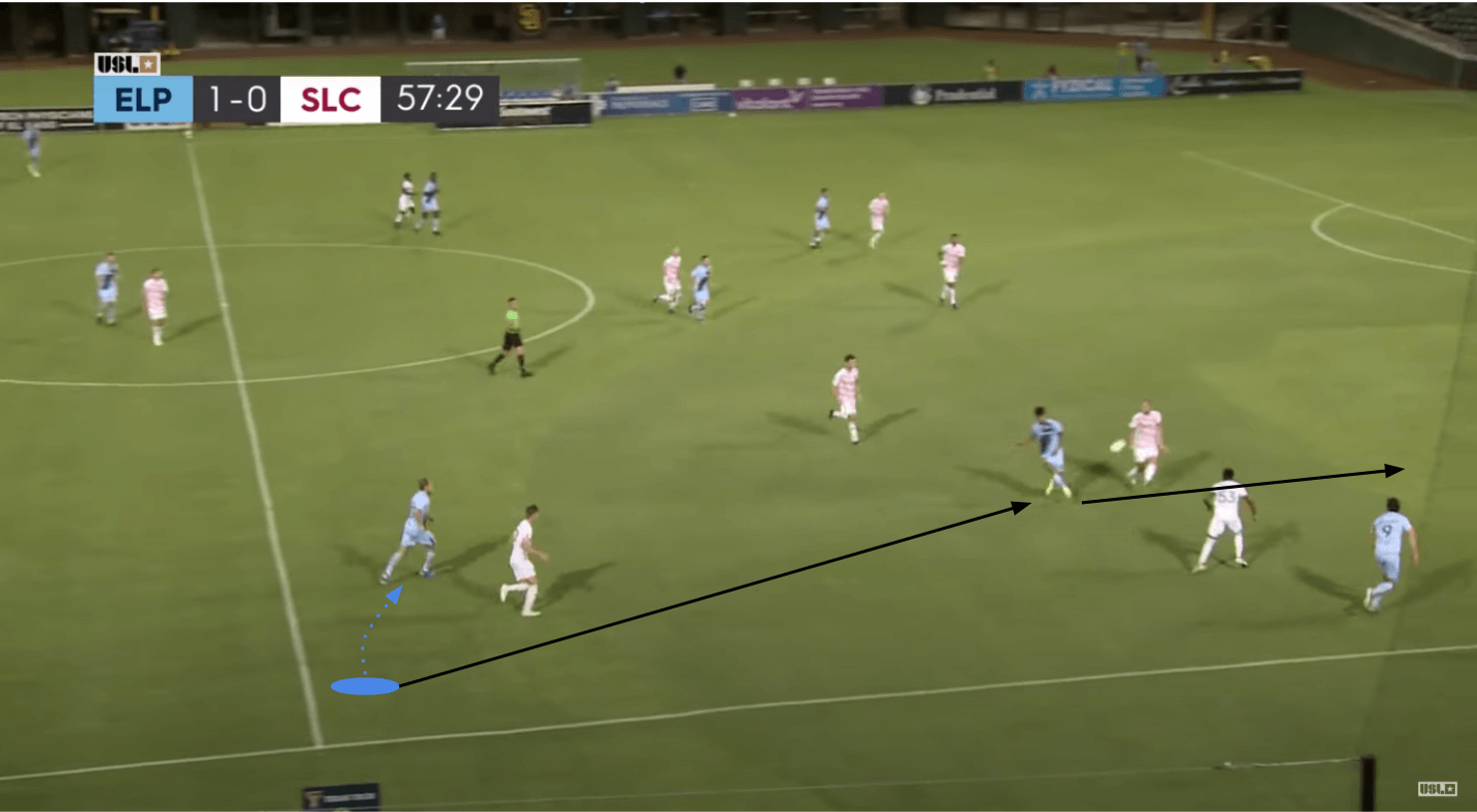
This principle can also be applied higher up the pitch if the opponent is playing a high backline. The initial pass needs to be spot on, but the touch from the man in the half-space just needs to get his teammate through on goal. Against the Monarchs, Macauley King was in possession on the right flank. He played a pass into Rebellón, who was able to use his first touch to send Omar Salgado in behind the defence. This passing combination is so lethal because it often ‘freezes’ outside backs who have to make a decision about their next moving. In this case, Salgado had a good headstart to get on the ball in the opponent’s final third.
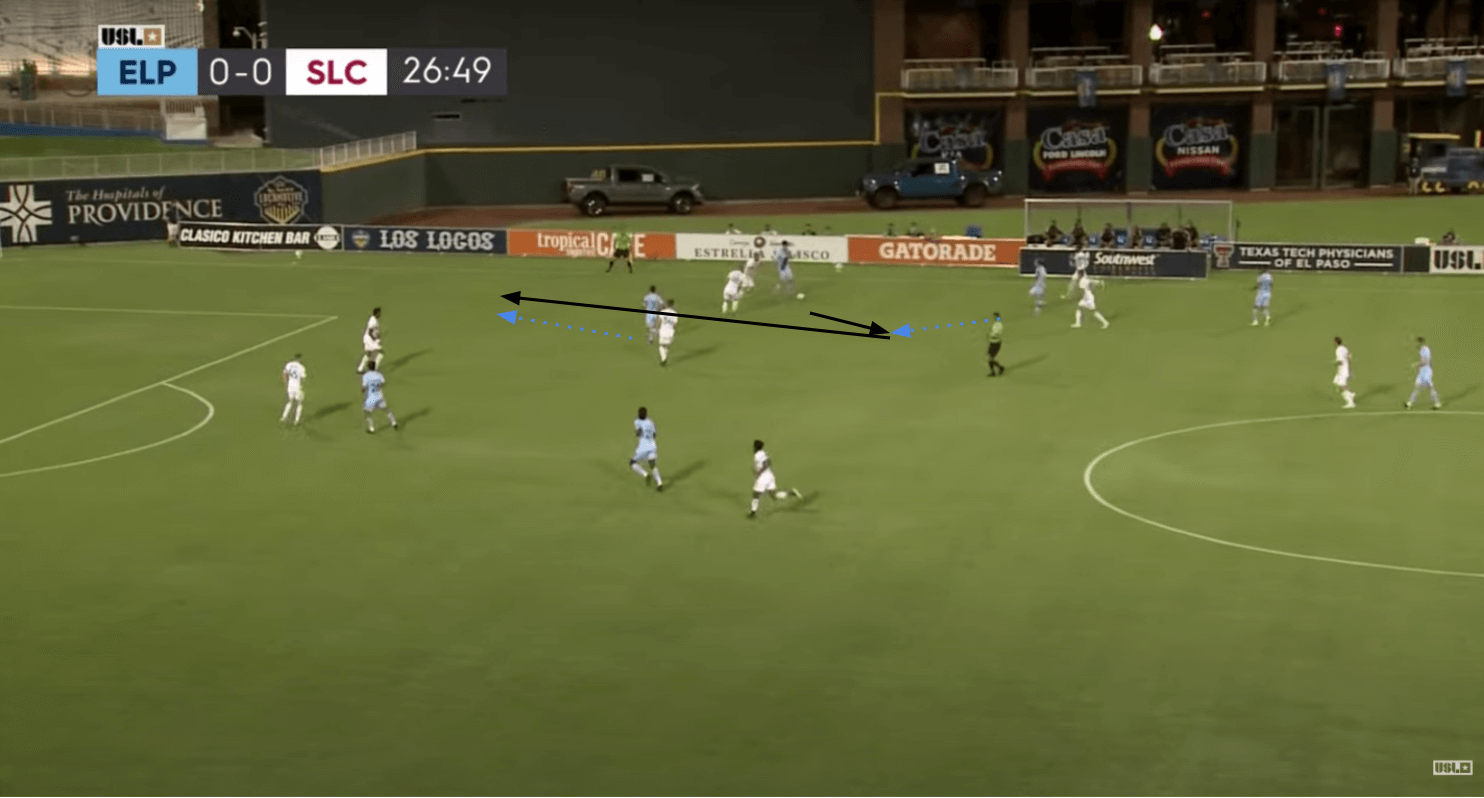
This final example shows a combination of most of the principles previously mentioned. King played a pass up the flank to Rebellón. Under pressure, Rebellón played the ball back into the half-space to King, who had made a supporting run and was now the forward-facing player. Josué Gómez recognised the space behind the defence, making a run towards the corner. Gómez was able to receive the ball in so much space because of all the attention that the initial move attracted. This allowed Gómez to deliver a cross into the box that El Paso was unable to capitalise on.
Conclusion
What isn’t clear in this scout report is that what is most exciting for El Paso supporters is that the team continues to develop from week to week. As they continue to build confidence and implement more of Lowry’s ideas, the more successful they become. Supporters will hope that this development will mirror the success of last season, where they only won 13 games out of 34, but they continued to improve throughout the season, ultimately earning themselves a spot in the Western Conference Championship match.




Comments